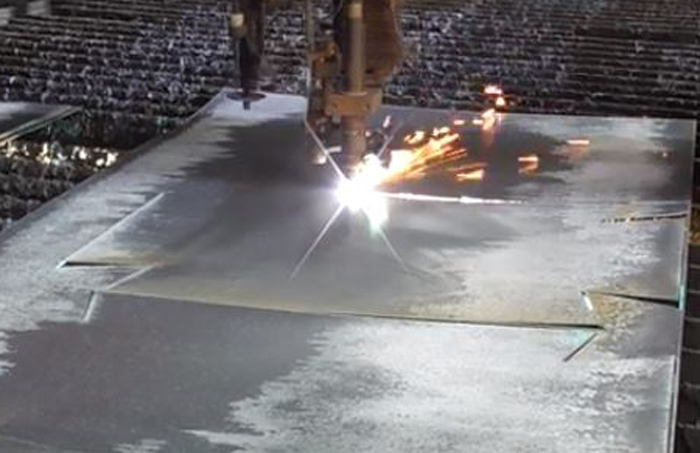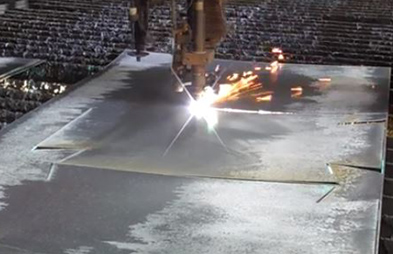Are you looking to cut through galvanized steel like a pro? Look no further. In this article, we will dive deep into the world of plasma cutting galvanized steel and explore how you can achieve clean and precise cuts every time. Galvanized steel poses a unique challenge when it comes to cutting, as the zinc coating can interfere with the cutting process. However, with the right techniques and equipment, you can overcome this obstacle and create professional-quality cuts.
Whether you are a DIY enthusiast or a professional fabricator, understanding the intricacies of plasma cutting galvanized steel can save you time, money, and frustration. From choosing the correct plasma cutter and consumables to implementing proper safety measures, this comprehensive guide will equip you with the knowledge you need to excel in your projects.

Photos by AvvinSkorceni on YT
So, if you are ready to take your cutting skills to the next level and get outstanding results with galvanized steel, let’s dive into the world of plasma cutting and discover the secrets to achieving flawless cuts every time.
What is Galvanized Steel and Why is it Used?
Galvanized steel is a type of steel that has been coated with a layer of zinc to protect it from rust and corrosion. The process of galvanization involves immersing the steel in a bath of molten zinc, which creates a strong bond between the zinc and the steel surface.
The zinc coating provides excellent protection against the elements, making galvanized steel a popular choice for outdoor applications such as fences, roofs, and structural supports. It is also commonly used in the automotive industry, construction, and manufacturing.
The benefits of galvanized steel include its durability, cost-effectiveness, and low maintenance requirements. However, when it comes to cutting galvanized steel, the zinc coating can present some challenges.
Challenges of Plasma Cutting Galvanized Steel
Plasma cutting is a widely used method for cutting various types of metal, but when it comes to galvanized steel, there are a few challenges to overcome. The zinc coating on galvanized steel can create issues during the cutting process, such as excessive smoke, slag buildup, and reduced cutting speed.
One of the main challenges is the high melting point of zinc compared to steel. This means that when the plasma arc comes into contact with the zinc coating, it can cause the zinc to melt and create a molten pool. This molten pool can interfere with the cutting process and result in a less precise cut.
Another challenge is the release of zinc fumes and smoke during the cutting process. These fumes can be hazardous to health if inhaled, and the smoke can also reduce visibility, making it difficult to see the cutting line. Despite these challenges, with the right techniques and equipment, you can achieve clean and precise cuts on galvanized steel.
Preparing Galvanized Steel for Plasma Cutting
Before you start plasma cutting galvanized steel, it is important to properly prepare the material to ensure the best results. Here are some steps to follow:
- Clean the surface: Remove any dirt, oil, or grease from the galvanized steel surface using a degreaser or a suitable cleaning solution. This will help improve the quality of the cut and reduce the risk of slag buildup.
- Remove the zinc coating: While it may seem counterintuitive, removing the zinc coating in the area to be cut can actually improve the cutting process. This can be done by using a grinder or a chemical stripper specifically designed for removing galvanization.
- Mark the cutting line: Use a marker or a scribe to mark the cutting line on the galvanized steel. This will help guide your plasma cutter and ensure accuracy.
By following these preparation steps, you can minimize the challenges associated with plasma cutting galvanized steel and achieve cleaner and more precise cuts.
Safety Precautions When Working with Galvanized Steel
Working with galvanized steel, especially during plasma cutting, requires taking proper safety precautions to protect yourself and those around you. Here are some essential safety measures to consider:
- Wear protective gear: Always wear appropriate personal protective equipment (PPE), including safety glasses, gloves, and a respirator. This will protect you from the zinc fumes, smoke, and potential sparks during the cutting process.
- Ensure proper ventilation: Plasma cutting galvanized steel can release toxic fumes and smoke. Make sure you are working in a well-ventilated area or use exhaust fans to remove the fumes. If working indoors, consider using a fume extractor or wearing a respirator with appropriate filters.
- Fire prevention: Keep a fire extinguisher nearby and clear the area of any flammable materials. The cutting process can generate sparks, so it’s important to take precautions to prevent fires.
By following these safety precautions, you can minimize the risks associated with plasma cutting galvanized steel and ensure a safe working environment.
Best Practices for Plasma Cutting Galvanized Steel
To achieve the best results when plasma cutting galvanized steel, it is important to follow some best practices. These practices will help you overcome the challenges and achieve clean and precise cuts. Here are a few tips to keep in mind:
- Use the right plasma cutter: Invest in a high-quality plasma cutter that is specifically designed for cutting galvanized steel. Look for a cutter that offers precise control of the plasma arc and has adjustable settings to accommodate the thickness of the material.
- Select the appropriate consumables: Choosing the right consumables is crucial for successful plasma cutting on galvanized steel. Opt for consumables that are designed to handle the challenges posed by the zinc coating. This includes selecting the correct nozzle size, electrode, and swirl ring.
- Adjust the cutting parameters: Fine-tuning the cutting parameters is essential to achieve optimal results. Experiment with different amperage, gas flow rate, and travel speed settings to find the right combination for your specific application.
- Maintain proper standoff distance: Maintaining the correct standoff distance between the plasma torch and the galvanized steel surface is crucial for achieving clean and precise cuts. Refer to the manufacturer’s recommendations for the appropriate standoff distance based on the thickness of the material.
By implementing these best practices, you can overcome the challenges of plasma cutting galvanized steel and achieve professional-quality cuts.
Common Issues and Troubleshooting Tips
Even with the best techniques and equipment, issues can still arise during plasma cutting on galvanized steel. Here are some common issues you may encounter and troubleshooting tips to help you overcome them:
- Excessive smoke and fumes: If you notice excessive smoke or fumes during the cutting process, check that your ventilation is adequate. Also, ensure that you are using the correct consumables and adjusting the gas flow rate as needed.
- Slag buildup: Slag buildup can occur when cutting galvanized steel. To minimize slag, adjust the cutting parameters to achieve a more focused and precise cut. You can also clean the slag off the cut edge using a wire brush or grinding tool.
- Uneven cuts: If you are experiencing uneven or jagged cuts, check that your plasma cutter is properly calibrated and that the consumables are in good condition. Also, ensure that you are using the correct cutting speed and standoff distance.
- Reduced cutting speed: If you find that your cutting speed is slower than expected, it may be due to the high melting point of the zinc coating. Consider using a higher amperage setting or adjusting the gas flow rate to increase the cutting speed.
By troubleshooting these common issues, you can overcome any challenges that may arise during plasma cutting galvanized steel and achieve the desired results.
Benefits of Plasma Cutting Galvanized Steel
Despite the challenges, plasma cutting galvanized steel offers several benefits. Some of the key advantages include:
- Precision: Plasma cutting allows for precise and intricate cuts on galvanized steel, enabling you to achieve complex shapes and designs.
- Speed: Plasma cutting is a fast and efficient method, allowing you to complete your projects in a shorter timeframe compared to other cutting methods.
- Versatility: Plasma cutting can be used on various thicknesses of galvanized steel, making it a versatile option for a wide range of applications.
- Cost-effective: Plasma cutting is a cost-effective method, as it requires minimal setup time and produces minimal waste.
By leveraging these benefits, you can take advantage of plasma cutting to enhance your projects involving galvanized steel.
Examples of Industries That Use Plasma Cutting on Galvanized Steel
Plasma cutting on galvanized steel is widely used across various industries. Some examples include:
- Construction: Plasma cutting galvanized steel is commonly used in the construction industry for applications such as structural supports, roofing, and metal framing.
- Automotive: The automotive industry utilizes plasma cutting on galvanized steel for manufacturing components, such as body panels, frames, and exhaust systems.
- Manufacturing: Many manufacturing processes involve the use of galvanized steel, and plasma cutting is often used to shape and fabricate the metal for various products.
- Metal fabrication: Fabricators use plasma cutting on galvanized steel to create custom parts, signage, and decorative elements.
The versatility of plasma cutting makes it a valuable tool across these industries and more.
The Future of Plasma Cutting Galvanized Steel
Plasma cutting galvanized steel can be a challenging task, but with the right techniques and equipment, it is possible to achieve clean and precise cuts. By understanding the challenges posed by the zinc coating and implementing the best practices outlined in this article, you can excel in your projects involving galvanized steel.
As technology continues to advance, plasma cutting on galvanized steel is expected to become even more efficient and accessible. With the ongoing development of plasma cutting machines and consumables specifically designed for galvanized steel, the future looks bright for those looking to cut through galvanized steel with ease.
